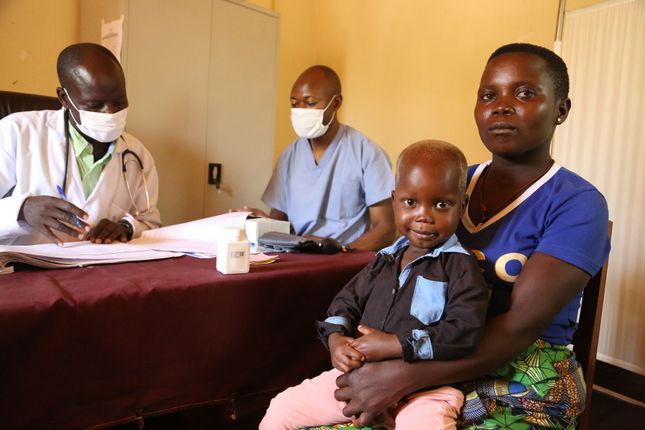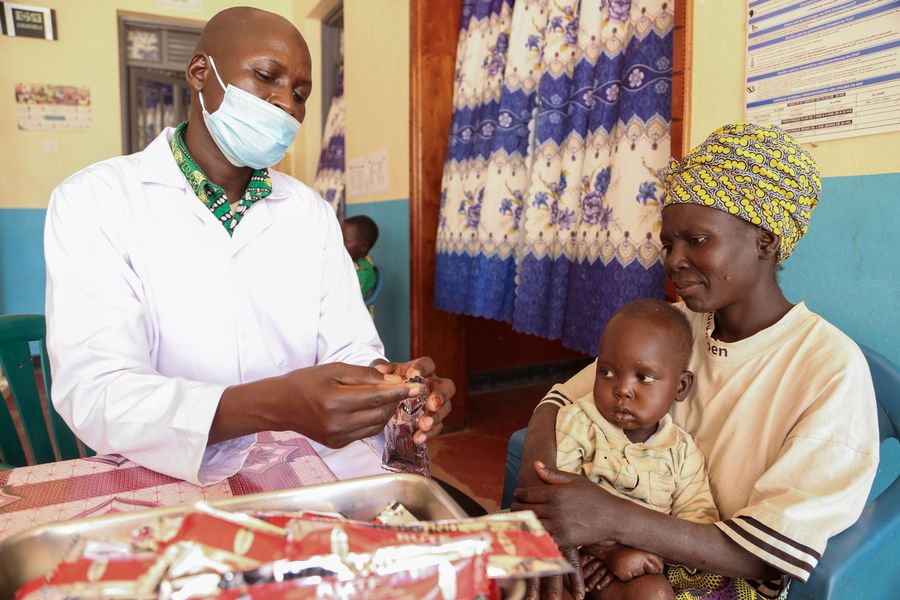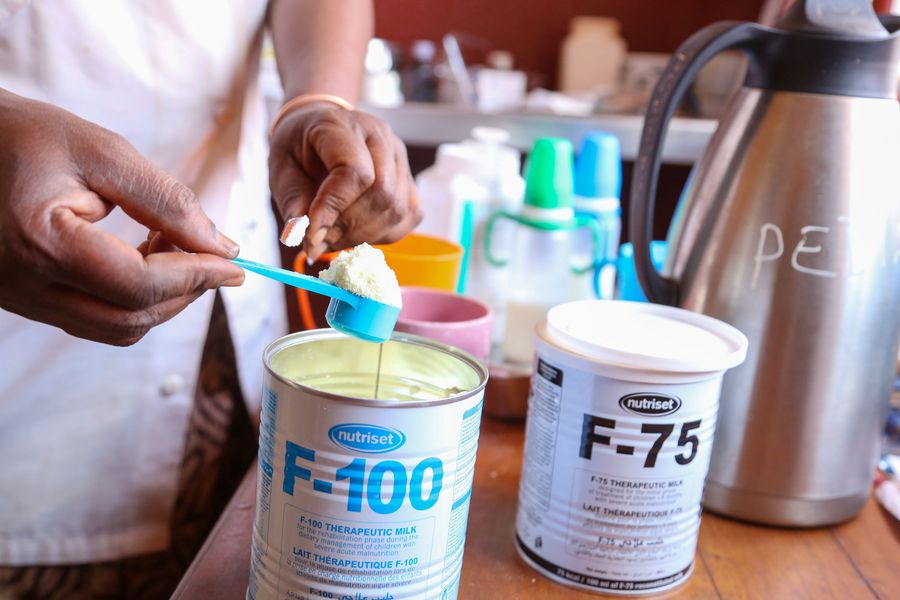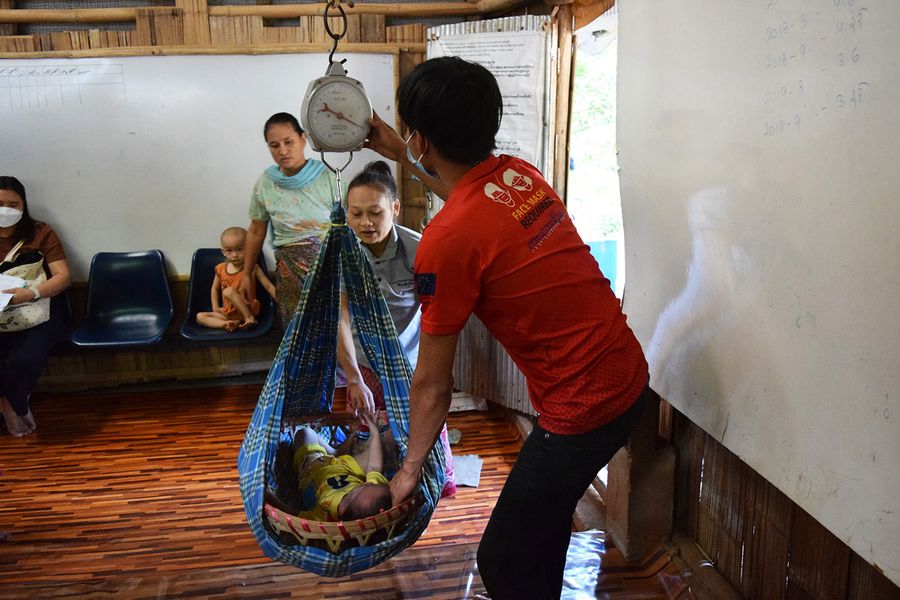
Combating child mortality together
There has been a positive downward trend in global child mortality for several years - the number has more than halved since 1990. Nevertheless, in 2021, an average of around 13,800 children worldwide died before the age of five every day. That means more than five million children will not live to see their fifth birthday. Many of these deaths are preventable. The child mortality rate shows: There is still extreme inequality between poor and rich countries, and between rich and poor populations within a country.
The main causes of child mortality - besides infant mortality - are diarrhea and pneumonia in children under 5. Among older children and adolescents, infectious diseases, traffic accidents, violence, suicides, pregnancy complications and noncommunicable diseases are among the main causes of death. Malnutrition is often an additional risk factor. By improving medical care and providing sufficient and healthy food, we can thus make a targeted contribution to further reducing the child mortality rate.
That is why we are committed to improving the lives of young children in regions particularly affected by child mortality, for example by strengthening health systems, providing basic immunizations, and ensuring children have access to essential nutrients, trace elements and vitamins, as well as providing supplementary food for malnourished girls and boys.
What is child mortality?

Every day, thousands of newborns and children die worldwide. Some infants do not survive birth, and many other newborns die after just a few weeks. Different definitions of infant mortality take into account various risk factors including age. Infant mortality, or under-five mortality, indicates how many girls and boys die per 1,000 live births within the first five years of life. Globally, that's an average of 38 children for every 1,000 live births. More than 80 percent of infant deaths occur in sub-Saharan Africa and South Asia.
Infant mortality, on the other hand, includes all deaths of babies under one year of age. If a newborn dies within the first month of life, this is referred to as neonatal mortality. Maternal mortality, on the other hand, in which women die partially during childbirth, often goes hand in hand with infant mortality and, like high infant mortality, is a global problem. In this text, we focus primarily on under-five mortality.
Positive trend: child mortality is declining worldwide
There has been a significant decline in global child mortality for several decades. Fewer children under the age of five are dying. From 1990 to 2021 alone, the mortality rate dropped by 59 percent. While the total number of deaths was 12.8 million in 1990, according to the United Nations Inter-Agency Group for Child Mortality Estimation (UN IGME), it was only 5 million in 2021. As such, the number of children dying before the age of five has more than halved, and the child mortality rate is at an all-time low. However, the numbers still remain alarmingly high with strong global disparities.
Child mortality in comparison: These countries are affected the most
In countries of the Global South – especially sub-Saharan African countries such as Niger, Somalia, Nigeria or South Sudan – young children have poor chances of survival. These regions present some of the highest child mortality rates worldwide. This clearly highlights the global inequalities between rich and poor regions of the earth: For children, the chances of survival are 15 times higher in Europe and North America and 19 times higher in Australia and New Zealand than in sub-Saharan Africa. Considering that a significant number of these fatalities are preventable, but the availability of resources and knowledge for prevention varies based on a country or person's wealth, clearly underscores the global disparities in child mortality. Due to improvements in the fight against childhood diseases and poverty reduction, however, there have been some positive developments in child mortality, leading to a decline of two-thirds in severely affected countries (including the sub-Saharan African region).
Child mortality is highest in African countries south of Sahara (sub-Saharan Africa):
| Country | Under-Five Mortality (Death cases per 1,000 births) (Estimates of the UN IGME for 2021) |
| Niger | 115 |
| Somalia | 112 |
| Nigeria | 111 |
| Chad | 107 |
| Sierra Leone | 105 |
| Central African Republic | 100 |
| Guinea | 99 |
| South Sudan | 99 |
| Germany | 3-4 |
The positive trend in declining child mortality rates can be partially attributed to the establishment of better healthcare systems in the past. Improvements in access to better nutrition, clean drinking water, and sanitation facilities have contributed to a reduction in infectious diseases and malnutrition among children. Simple yet effective prevention measures such as vaccinations have helped to decrease the incidence of diseases like measles, tetanus, and polio in children under five. Furthermore, the education of women and girls, as well as boys' access to education, represents the most significant non-medical factor in the reduction of child mortality. Poverty, ethnicity, and education are the three biggest influencers and obstacles in improving child mortality rates in affected countries.
Causes of child mortality in countries of the Global South

Infectious diseases such as pneumonia, diarrhea or malaria are among the most common causes of death in children. Other causes are chronic diseases, but also traffic accidents. These diseases usually occur in combination with heightened risk factors. Children who suffer from acute malnutrition for instance are particularly vulnerable, since their body is too weakened to successfully combat the infectious disease.
This also applies to premature births and children, who did not receive adequate medical and hygienic care during and after birth. Access to quality and affordable medical care as well as life-saving measures is equally important.
- Pneumonia: For young children, pneumonia is by far the leading cause of death. The disease would be preventable or highly treatable in many boys and girls. The deaths are due to a fatal combination of malnutrition, adverse living conditions and infectious disease.
- Diarrheal diseases: Diarrheal diseases are also a major health risk for children under five in poorer countries. With the right medical care, many children in affected countries could be protected from the disease and, above all, treated well in the event of illness. Often, a short stay in a health center is enough to rehydrate.
- Other infectious diseases, such as malaria: Malaria occurs mainly in tropical and subtropical regions and, as one of the most dangerous infectious diseases, poses a great risk for all generations. However, especially babies and young children often die as a result of malaria infection. In African countries, malaria deaths among children under five years of age account for two-thirds of all fatal malaria infections occurring there (source: WHO - as of 2020).
Malnutrition as an additional risk factor

Malnutrition in children is considered one of the major risk factors for increased mortality in the early years of life. In 2019 alone, it is estimated that 5.2 million girls and boys under the age of five died. Childhood malnutrition or undernutrition is a contributing factor in about half of these deaths. With adequate nutrition and a balanced diet, many such cases could be prevented and child mortality reduced in many parts of the world.
Malnourished children often show delayed physical and mental development. They are usually too small and too light compared to normally nourished children. Tiredness and weakness are also among the symptoms. Infants lack important minerals, vitamins or trace elements, which ultimately also weakens the children's immune system. They are particularly at risk of contracting infectious diseases such as tuberculosis or malaria.
Even with simple means, we help on site to treat the children in case of acute malnutrition or undernourishment, to prevent this in the long term through preventive measures and thus to minimize the risk of mortality.
The impact of the COVID-19 pandemic on infant and child mortality
There is little reliable evidence to support the notion that the COVID-19 pandemic has directly caused a rise in infant and child mortality rates (as of January 2023). However, available data from October 2022 suggest at least a small direct impact of COVID-19 on infant mortality. Nevertheless, many consequences of the pandemic indirectly contributed to increased risk, such as economic consequences that led to extreme increases in global hunger. Temporarily reduced access to health care and depleted health care systems also had fatal consequences. It will take some time to fully comprehend the precise impact of the COVID-19 pandemic on child mortality.
Here's how we help reduce child mortality

All children have a right to a good childhood, including the right to survive and grow up healthy, as set out in the 1989 UN Convention on the Rights of the Child. The convention establishes that children have the right to protection from violence, access to education, and the right to life, among other things. While these rights may seem obvious, it is vital to continue advocating for Children’s rights worldwide. Childhood is a crucial and formative phase in life, so babies and children need special protection and our support.
In the 2030 Agenda, the United Nations also specifically defines a reduction in maternal and child mortality as one of the 17 Sustainable Development Goals (SDGs). By 2030, with the help of the developmental goal on "health and well-being," fewer newborns and children are to die from preventable causes of death or treatable diseases, so that their overall life expectancy continues to increase.
To achieve this goal, health care, especially in poorer countries, must be improved and made accessible to all. This includes ensuring that more children receive immunization through equitable distribution of vaccines.
To counteract child mortality in our project countries, we focus on various measures in the areas of health, WASH and food security. In countries such as Colombia, Thailand, Bangladesh and the DR Congo, our goal is to improve access to medical care and ensure quality health services. To this end, we train and develop medical staff, supply health centers with medicines and equipment, and ensure the provision of WASH services (water, sanitation and hygiene).
This makes it possible for children to receive high-quality primary and, in some cases, secondary care at the health facilities we operate or support. By providing medicines for the chronically ill, infusions for diarrheal diseases, antibiotic therapy for pneumonia and vaccinations, for example, we implement measures that are essential for reducing child mortality.

We also raise awareness on preventive measures in the areas of health, hygiene and nutrition. It is particularly important to prevent the risk factor of malnutrition. To this end, we inform (expecting) mothers and families in special workshops about healthy and balanced nutrition, breastfeeding, but also on the prevention of infectious diseases, for instance.
As part of our activities, we provide support for expectant mothers and children who are either malnourished or at risk of malnutrition. This includes the provision of supplementary food and long-term monitoring and care by our counselors. In addition, we work to ensure that basic food services are available to those in need. In Colombia, for instance, we provide a monthly food basket for four months to those who are malnourished.
In addition to these direct measures, we also carry out activities that aim to prevent malnutrition and undernourishment in the long term. The activities help families to be self-sufficient e.g. by providing training in fruit and vegetable cultivation, distributing seeds, and providing agricultural equipment.








